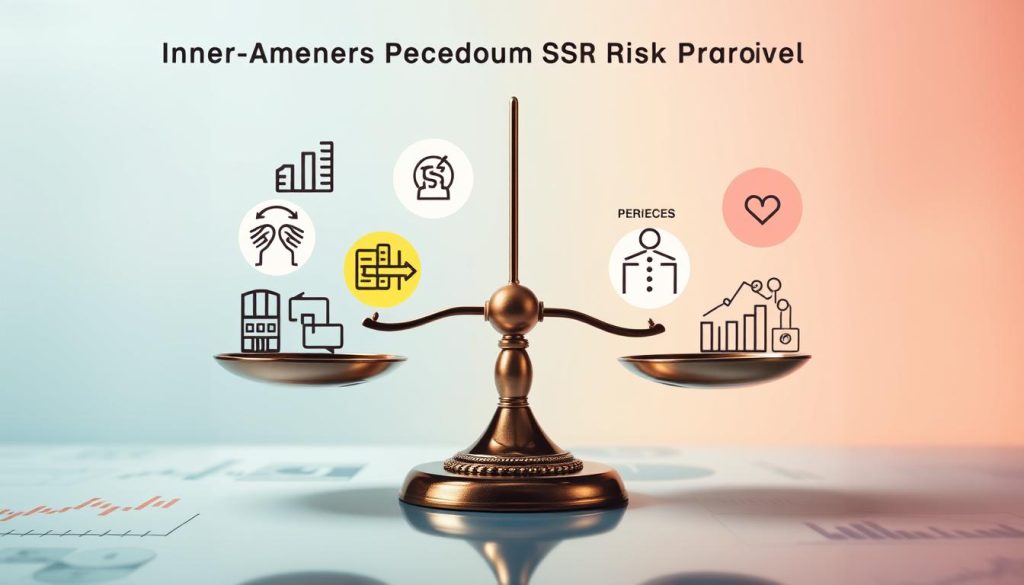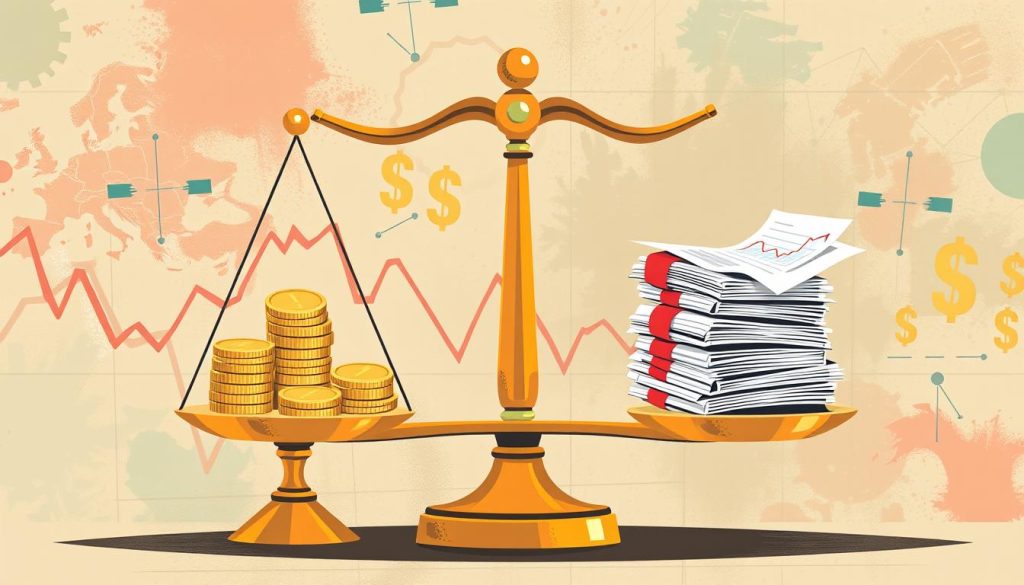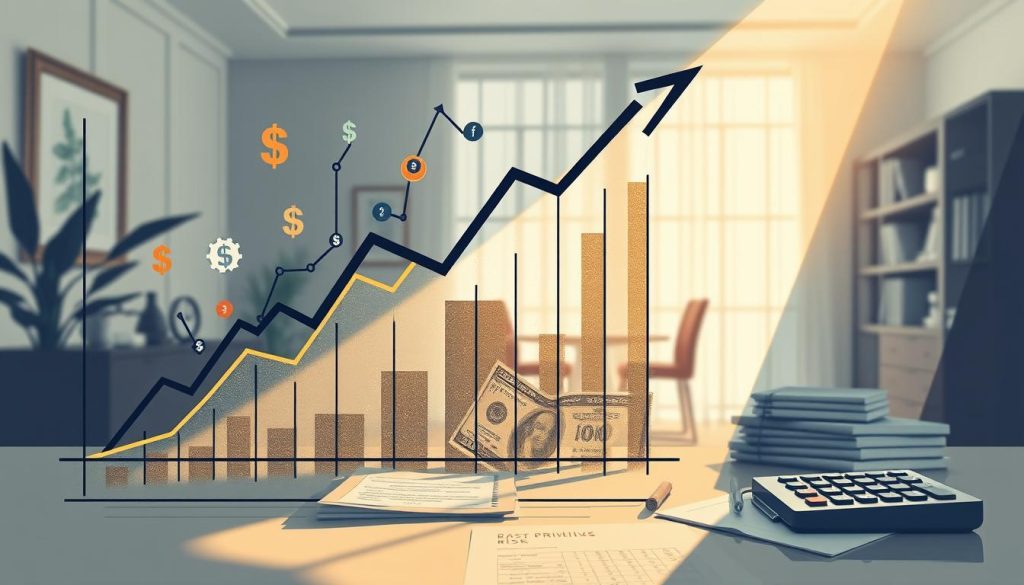For financial experts, grasping the default risk premium is key. It’s the extra interest charged on debt to cover the risk of not getting paid back1. This extra cost is crucial in figuring out the total interest rate. It’s mixed with other factors like liquidity premium, maturity premium, expected inflation, and the risk-free rate.
Your credit score and how well you manage debt affect the default risk premium. If you’ve always paid back on time, you’re seen as less risky. This means you’ll pay less extra interest1. But, if you’ve had trouble paying debts, you’ll pay more because lenders see you as a bigger risk.
Lenders also look at how liquid and profitable an entity is when setting the default risk premium. They check the balance sheet and cash flow to see if you can pay back your debts1. If you make steady money and have a solid financial picture, you’ll likely pay less extra interest. Having assets you can use as collateral can also make you more appealing to lenders. But, it doesn’t directly change the default risk premium.
Key Takeaways
- Default risk premium is the difference between the interest rate of a debt instrument and the risk-free rate, compensating investors for an entity’s likelihood of defaulting.
- Credit history and creditworthiness are primary factors influencing default risk premiums, with good credit history leading to lower premiums.
- Liquidity and profitability of an entity, as demonstrated by their financial statements, also impact default risk premiums.
- Collateralizable assets may increase an entity’s attractiveness to lenders, but do not directly affect the default risk premium.
- Components of an interest rate for bond investors include default risk premium, liquidity premium, maturity premium, projected inflation, and the risk-free rate.
What is Default Risk Premium?
The default risk premium is key in finance. It’s the extra return investors want for the risk of a borrower not paying back their debts2. This extra return is on top of the risk-free rate. It depends on how likely the borrower is to default3.
Definition and Key Components
The default risk premium is what makes the interest rate higher for bonds from companies seen as riskier2. These companies pay more interest because they’re seen as less reliable2. To figure out this premium, you subtract the risk-free rate, inflation, and other costs from the bond’s total APY2.
Let’s say a company’s bonds have a 7% APY. The risk-free rate is 0.5%, inflation is 2.5%, and the liquidity and maturity premiums are both 1%. That means the default risk premium is 2%2. This extra is for the higher risk of the company not paying back2.
What affects the default risk premium includes the borrower’s credit history, how easy it is to sell the bond, and how profitable the company is2. Investors look at these things to guess the chance of default and set the right price for the risk3.
Knowing about default risk premium helps finance experts make better choices when dealing with debt4. This info lets them set a risk level for an asset and figure out the return needed for that risk4.
Factors Influencing Default Risk Premium
The default risk premium is the extra interest lenders charge to cover the risk of borrowers not paying back. Several key factors affect this premium5. A big one is the borrower’s credit history. A good credit history means on-time payments and low late fees. This makes lenders think the borrower is less likely to default5.
A poor credit history, with late payments or bankruptcies, means a higher risk premium. This is because lenders see the borrower as more likely to not pay back.
Lenders also look at the borrower’s money flow and profits. Being liquid and profitable shows the borrower can pay back debts. So, those with strong money flow and profits get a lower risk premium5.
What the borrower owns and can sell if needed also matters. Having lots of assets makes lenders think the borrower is safer5. Having things like real estate or valuable items as collateral gives lenders another way to get their money back. This lowers the risk premium.
| Factor | Impact on Default Risk Premium |
|---|---|
| Strong Credit History | Lower Default Risk Premium |
| Healthy Liquidity and Profitability | Lower Default Risk Premium |
| Ample Asset Ownership and Collateralization | Lower Default Risk Premium |
| Poor Credit History | Higher Default Risk Premium |
| Weak Liquidity and Profitability | Higher Default Risk Premium |
| Limited Asset Ownership and Collateralization | Higher Default Risk Premium |
The default risk premium is key in setting interest rates and financial prices. Knowing what affects this premium, like credit history and asset ownership, helps financial experts make better lending and investment choices5.

Default Risk Premium in Interest Rates
Interest rates have several key parts, like the default risk premium, liquidity premium, maturity premium, and more6. The default risk premium is key because it helps investors get paid for the risk of the borrower not paying back the debt6.
Breaking Down Interest Rate Components
The risk-free rate, from government securities, is the base of interest rates6. Investors add more to this for things like how easy it is to sell the bond, its term, and inflation’s effect6. The default risk premium helps cover the risk that borrowers might not pay back because they can’t afford to6.
In the U.S., government bonds have a default risk of 0.00%, showing little risk7. But Argentina’s government bonds have a 4.00% risk, showing more risk7. Companies in Japan and Vietnam also have different risks, with Japan’s Aa1 rated company at 60 basis points and Vietnam’s B1 rated company at 10.60%7.
The default risk premium is the difference between the bond’s interest rate and the risk-free rate4. This premium is a payment to investors if the borrower doesn’t pay back the debt. It depends on the borrower’s credit, how easy it is to sell the bond, and its profits4.
Knowing about the parts of interest rates helps financial experts understand risks and potential gains from different investments6. This info helps them make better choices and manage their money better6.
Understanding the Risk Premium
Investing involves understanding the risk premium. It’s the extra return you get from investing in stocks compared to risk-free assets like government bonds8. This extra return is for taking on more risk8.
The equity risk premium is the extra return from the stock market8. The market risk premium is what investors want for choosing the market over safe assets8. These premiums help figure out the needed returns in financial models like the CAPM. Historically, the market risk premium has been about 5.5% in the U.S., based on government bond yields9.
| Investment | Return | Risk Premium |
|---|---|---|
| Corporate Bond | 6.0% | 3.0% |
| U.S. Treasury Bond | 3.0% | N/A |
The default risk premium is what lenders want for the risk of a security defaulting9. It’s found by subtracting the risk-free rate from a risky asset’s interest rate, like a corporate bond9. For instance, if a corporate bond yields 6.0% and the risk-free rate is 3.0%, the default risk premium is 3.0%9.
“Higher default risk leads to a higher default risk premium and interest rates.”9
In summary, the risk premium is the extra return investors want for holding risky assets over risk-free assets. Knowing about different risk premiums, like the equity and market risk premiums, helps financial experts make better investment choices9108.

The Equity Risk Premium
Calculation and Historical Trends
The equity risk premium (ERP) is the extra return investors get from the stock market over the risk-free rate11. This extra return is for taking on more risk with stocks compared to the safety of government bonds or other low-risk investments11.
The ERP is figured out using the capital asset pricing model (CAPM). It looks at the risk-free rate, the market return, and the stock’s beta11. For instance, if a government bond gives a 6% return and a stock gives a 14% return, the ERP would be 8%11.
From 1928 to 2022, the U.S. ERP has averaged about 5%12. But it has changed a lot over time12. The ERP is affected by the market return and the risk-free rate. It tends to be higher when the market return is up and the risk-free rate is down11.
| Metric | Value |
|---|---|
| S&P 500 P/E Ratio (2022) | 20.47 |
| S&P 500 Earnings Yield | 4.89% |
| Dividend Yield Estimate | 1.68% |
| Dividend Growth Rate Estimate | 2% – 3% |
| Inflation-adjusted 10-year TIPS Yield | 1.20% – 2.23% |
| Estimated Equity Risk Premium | 2.0% – 3.0% |
The ERP is a forward-looking metric that helps investors make better asset allocation decisions11. By looking at current and past ERP trends, financial experts can better understand the risks and rewards of equity investments12.
“The equity risk premium is a critical input for many financial models and decisions, and its accurate estimation is crucial for portfolio optimization and asset allocation.”
Default Risk Premium: Implications for Investors
Understanding the default risk premium is key for smart investing. It’s the extra pay investors want for taking on the risk of a bond or debt failing1314.
When default risk is high, bond yields go up. Investors want more money to make up for the risk of not getting their money back14. Companies with low credit ratings pay more to get investors on board. This is because they’re seen as riskier14.
Watching the default risk premium helps investors see how the market views a company’s financial health. This info can shape their investment plans. It helps them spot bonds that might be too cheap or too expensive14.
| Metric | Value |
|---|---|
| Market Risk Premium | 3.60% |
| Expected Return on Market Portfolio | 8.60% |
| Excess Return in Good Weather | 12.60% |
| Excess Return in Bad Weather | -5.40% |
| “Good Security” Risk Premium | 70% |
| “Bad Security” Risk Premium | -30% |
Knowing about the default risk premium helps investors make better choices for their bond investments. This info can lead to better returns in the bond market1314.
“Monitoring the default risk premium is essential for investors seeking to optimize their fixed-income portfolios and manage their overall investment risk exposure.”
In summary, the default risk premium is vital for investors. Staying updated on this can help you improve your portfolio and handle bond market risks1314.
Conclusion
Knowing about the default risk premium is key for finance experts. It affects the earnings and risk levels of investments like bonds15. By looking into what changes the default risk premium, you can improve how you handle credit risk. This helps in making smarter investment decisions and fine-tuning your investment mix15.
The default risk premium is a big part of what makes interest rates what they are. Right now, the ten-year treasury yield is at 3.98%16. It’s a key factor in the financial world, shaped by things like a company’s credit score, profits, and what people think about inflation16.
Grasping the default risk premium helps you make better investment decisions. It also helps in managing the risk premium in your investments1516.
FAQ
What is a default risk premium?
A default risk premium is the extra return investors want for the risk of a borrower not paying back their debts. It’s the extra money they expect to make over the risk-free rate. This reflects how likely the borrower is to default.
What factors determine the default risk premium?
The main things that affect the default risk premium are the borrower’s credit history, how liquid and profitable they are, and what assets they own. A good credit history, being able to quickly sell assets, being profitable, and having lots of assets to use as collateral lowers the default risk premium. On the other hand, a bad credit history, not being able to easily sell assets, not being profitable, and not having much collateral raises the default risk premium.
How does the default risk premium fit into the overall interest rate structure?
The minimum return an investor wants includes several parts: the default risk premium, the liquidity premium, the maturity premium, the expected inflation, and the risk-free rate. The default risk premium pays the investor for the chance the borrower won’t pay back their debt. The other parts cover things like how easy it is to sell the bond, how long until it matures, and how much it will cost to buy things in the future because of inflation.
What is the difference between a risk premium and a default risk premium?
A risk premium is the extra return investors get from choosing riskier investments like stocks over safe investments like government bonds. This premium rewards investors for taking on more risk. The default risk premium, however, is the extra return investors want for the risk that a borrower might not pay back their debts.
How is the equity risk premium calculated and what are the historical trends?
The equity risk premium (ERP) is the extra return investors can expect from stocks over the risk-free rate. It’s figured out using the capital asset pricing model (CAPM), which looks at the risk-free rate, the market return, and the stock’s beta. Over the years from 1928 to 2022, the U.S. ERP has averaged about 5%, but it has changed a lot.
How does the default risk premium impact investors and their investment decisions?
The default risk premium affects investors, especially those in bonds and other debt. A higher default risk premium means higher bond yields because investors want more return for the higher credit risk. Investors should watch the default risk premium when making investment choices. It helps them decide where to put their money and spot bonds that might be too cheap or too expensive.

